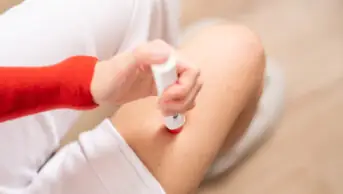The news media are again reporting on measles outbreaks, not only in the UK, but also in the Philippines, New Zealand, Australia, France, Italy, Germany, and Bulgaria. Our NHS is, understandably, urging parents and carers to ensure that their children are immunised. However, we pharmacists (and indeed GPs, nurses, midwives, etc), not to mention the manufacturers, should be asking ourselves whether we are not inadvertently contributing to these outbreaks by encouraging the use of paracetamol and ibuprofen for “post-vaccination pyrexia”.
In chapter 8 of the “Green book” (Immunisation against infectious disease; see bit.ly/1bczjhW), the Department of Health provides advice (originally updated in May 2011; see bit.ly/1bczpWX) that neither paracetamol nor ibuprofen should be used routinely to prevent fever following vaccination. Yet, to this day, I see that (some) GPs and nurses are routinely providing parents of children who have just attended a clinic for their measles, mumps and rubella vaccination with a prescription for paracetamol. And I hear that advice is being given (in at least one pharmacy in south Wales) that paracetamol should be given immediately following the baby’s MMR vaccination to prevent fever.
The advice in the “Green book” is based on the findings of a study published in 2009 by Prymula et al (bit.ly/1bczpWX) entitled “Effect of prophylactic paracetamol administration at time of vaccination on febrile reactions and antibody responses in children: two open-label, randomised controlled trials”. The study demonstrated that paracetamol can reduce the antibody response to several vaccine antigens. Put another way, if the child develops a fever, this shows that the vaccination is “taking”. If the fever is prevented, the vaccination may not take.
Although it is now well established that the MMR vaccine does not cause autism, a thought-provoking article published in 2009 (bit.ly/1bejnf8) provides a rather compelling suggestion that the autism epidemic, which mirrors the epidemic of asthma and eczema in terms of its onset in the 1980s, may actually be linked to the use of paracetamol to treat fever and pain following vaccination. A similar tale could probably be told linking paracetamol use to the peanut allergy epidemic.
These and other issues associated with the use of paracetamol during pregnancy are explored in detail in an article entitled “Paracetamol: its dark side” published in the July 2013 issue of the National Association of Women Pharmacists magazine (bit.ly/1a7GxWf), which I would urge pharmacists to read before they next dispense or recommend the use of paracetamol in pregnancy or in young children.
Richard J. Schmidt
Penarth, Vale of Glamorgan


